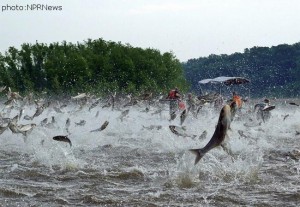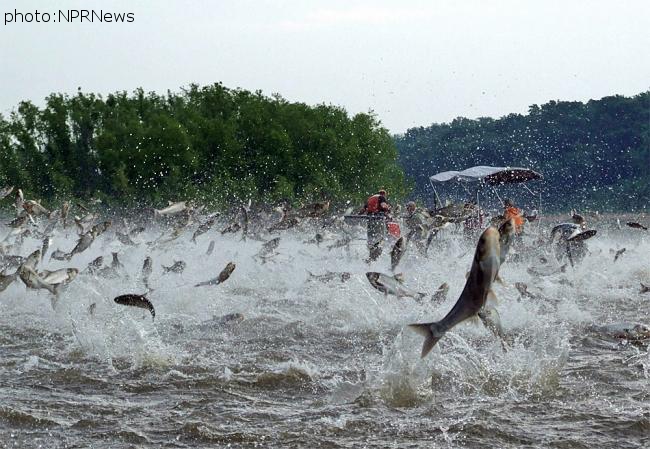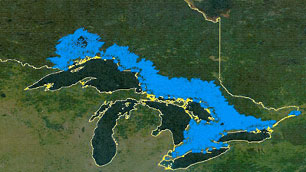 The Great Lakes are one of the world’s most important natural resources – holding one fifth of the world’s fresh surface water, home to more than 150 species of fish, and vital to the economy of Ontario and neighbouring U.S. states. But several kilometres from Lake Michigan lurks a threat that could change the Great Lakes forever. The fish known as Asian carp could wipe out native fish species, devastate sport and commercial fisheries, and cause far-reaching changes to the Great Lakes ecosystem.
The Great Lakes are one of the world’s most important natural resources – holding one fifth of the world’s fresh surface water, home to more than 150 species of fish, and vital to the economy of Ontario and neighbouring U.S. states. But several kilometres from Lake Michigan lurks a threat that could change the Great Lakes forever. The fish known as Asian carp could wipe out native fish species, devastate sport and commercial fisheries, and cause far-reaching changes to the Great Lakes ecosystem.
If you need proof of the danger to the Great Lakes, take a look at the Mississippi River Basin. After escaping from aquaculture ponds in the southern U.S. in the 1970s and 80s, Asian carp have spread steadily northward. In parts of the Mississippi and other rivers, invasive, voracious Asian carp have crowded out native fish and make up as much as 90 per cent of all fish by weight. Only electric barriers in a canal near Chicago are currently keeping the fish out of Lake Michigan.
The need for a coordinated plan to fight Asian carp led the Ontario Ministry of Natural Resources, with support from the Department of Fisheries and Oceans Canada, to host a “table-top exercise” in March. The exercise simulated an incident where Asian carp get into Ontario waters. The aim was to test if the agencies involved are ready to respond quickly and effectively.
“Preventing Asian carp from spreading into the Great Lakes is the most cost-effective control measure we’ll ever have,” says Ontario Minister of Natural Resources Linda Jeffrey. “This exercise was about making sure all the agencies involved work together, and identifying areas where we’re vulnerable.”
For the March exercise, participants rehearsed how they would respond IF an accident on a bridge over the Thames River in southwestern Ontario caused a truckload of live Asian carp to be dumped in and near the river. It was a timely choice – only a week earlier a fish importer had been fined $50,000 for trying to truck 1,800 kilograms of live Asian carp across the Windsor/ Detroit border to sell in the Greater Toronto Area. It’s illegal to possess live Asian carp in Ontario.
The term “Asian carp” includes four species – bighead, silver, grass and black carp. The bighead and silver carp currently pose the biggest threat. They weigh up to 45 kilograms and can grow to more than a metre long. As filter feeders that can eat 20 per cent of their body weight a day in plankton, they’re able to grow and multiply faster than native species. In some areas in the U.S. carp populations are doubling every year.
Silver carp are also a hazard to people on the water. When disturbed by boat motors, the fish jump as much as two metres out of the water. Boaters and water skiers on the Illinois River have already been hit and injured.
Canadian and U.S. experts agree that Asian carp would thrive in the Great Lakes, and that quick action is the only way to prevent Asian carp from spreading if they are found in the Great Lakes Basin.
During the table-top exercise, local MNR staff described how they would place nets upstream and downstream to catch and identify fish in the river, test the fish to find out if they could reproduce, and confirm if the river habitat was suitable for Asian carp. The agencies involved also had to decide if any local species at risk might be harmed by the control measures, and keep governments, partners, the public and the media informed.
“Ontario’s recreational fishery contributes $500 million to the province’s economy each year, our commercial fishery is worth up to $215 million a year, and the Great Lakes ecosystem is priceless,” says Minister Jeffrey. “With so much at stake, we have to be prepared.” For the Silo, Lacey Williamson.



Leave a Reply
You must be logged in to post a comment.